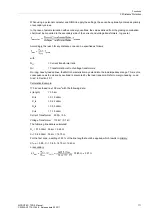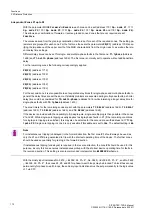
Functions
2.6 Power Swing Detection (optional)
SIPROTEC, 7SD5, Manual
C53000-G1176-C169-5, Release date 02.2011
184
Power Swing Blocking
The power swing blocking function blocks the tripping of the distance protection for specific zones (which are
set under address
2002
P/S Op. mode
) phase-selectively:
• Blocking of the trip command for all zones (
All zones block
): The trip command of the distance protec-
tion is blocked for all zones during a power swing.
• Blocking of the trip command for the first zone only (
Z1/Z1B block
): Only the trip command of the first
zone and of the overreaching zone (Z1 and Z1B) are blocked during a power swing. A pickup in a different
zone (Z2 and higher) can lead to a trip command in the case of a power swing after the associated grading
time has expired.
• Blocking of the trip command for the higher zones only (
>= Z2 block
): Z2 and the higher zones are blocked
for the tripping during a power swing. Only a pickup in the first zone or the overreach zone (Z1 and Z1B) can
lead to a trip command.
• Blocking of the first two zones (
Z1,Z1B,Z2 block
): The trip commands of the first and second zone (Z1
and Z2) and the overreaching zone (Z1B) are blocked during a power swing. A pickup in a different zone
(Z3 and higher) can lead to a trip command in the case of a power swing after the associated grading time
has expired.
Figure 2-80
Blocking logic of the power swing supplement
Power Swing Tripping
If tripping in the event of an unstable power swing (out-of-step condition) is desired, the parameter
PowerSwing trip
(address
2006
) =
YES
is set. If the criteria for power swing detection are met, the distance
protection is initially blocked according to the configured program for power swing blocking, to avoid tripping by
the distance protection.
When the impedance vectors identified by the power swing detection exit the pickup characteristic APOL, the
sign of the R components in the vectors are checked to see if they are the same on exiting and entering the
pickup polygon. If this is the case, the power swing process is inclined to stabilize. Otherwise, the vector has
passed through the pickup characteristic (loss of synchronism). In this case, stable power transmission is no
longer possible. The device outputs an alarm to that effect (No 4163
„P.Swing unstab.“
). The alarm No.
4163
„P.Swing unstab.“
is a pulse with a duration of approx. 50 ms, which can also be processed further
via output relays or CFC links, e.g. for a cycle counter or a pulse counter.
If instability is detected, the device issues a three-pole trip command, thereby isolating the two system seg-
ments from each other. Power swing tripping is signalled.
Indication No. 4177
„P.Swing unst. 2“
will already be transmitted when the impedance vector passes the
polygon bisect through the origin. The angle of this straight line corresponds to the inclination angle of the poly-
gons (address
1511
Distance Angle
). Normally, this straight line is identical with the impedance character-
istic of the power line. This indication is also a pulse with a duration of approx. 50 ms, which can also be pro-
cessed further via CFC logic operation. However, it does not result in power swing tripping.










































